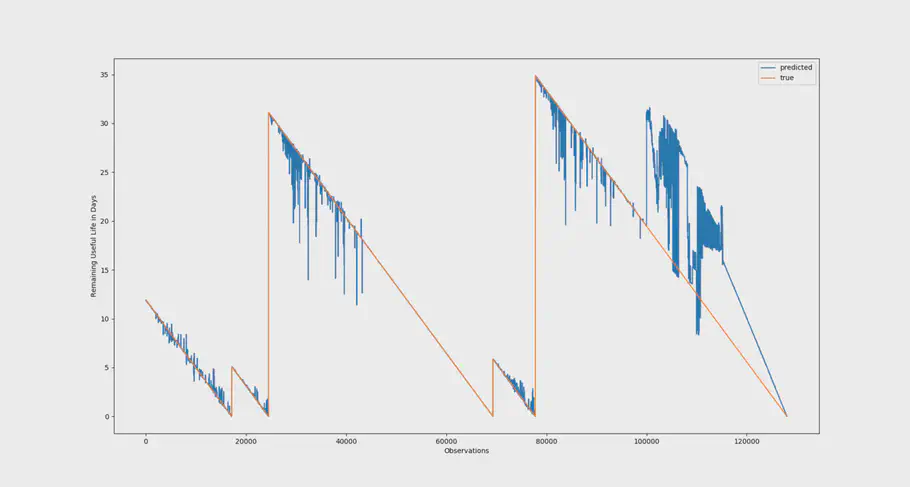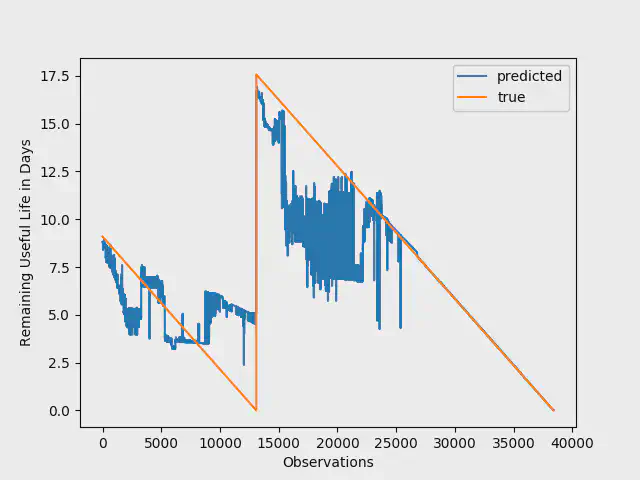In this blog post, we will talk about the benefits of using Remaining Useful Life predictions as a main driver for planning maintenance and detecting wear and tear before problems arise. There is a high potential of both reducing total costs on maintenance and spare parts, but also on increasing the total operational uptime, by using data when planning maintenance intervals.
In our previous blog post about different approaches towards predictive maintenance we showed two different types of breakdowns, that we aim to see before they happen by utilizing machine learning and statistics. The first failure type is sudden failures, which have a higher probability of occuring in the early stages in the lifetime of an asset. We estimated the probability of sudden failures occurring on the same water pump, in predicting machinery breakdown on a water pump
With such a model, we were able to detect all the breakdowns 7-61 minutes before they occurred.
This means that it is possible, even with small datasets, to detect sudden breakdowns minutes to hours before they happen.
A Remaining Useful Life model can predict the second type of breakdown: Wear and tear. This type of breakdown has a higher probability of occurring when the water pump is older and components have run for a longer period of time. A Remaining Useful Life prediction, estimates how many years, months, weeks, or days the water pump has left, before it will cause a breakdown due to wear and tear.
The benefits of being able to detect these breakdowns are many, such as:
- Reduced costs on spare parts (run them longer and have less in stock)
- Reduced costs on maintenance
- Reduced costs on overtime
- Reduced costs on discarded batches due to breakdowns
- Improved uptime
- Improved customer satisfaction (if you have a lean production and produce Just-in-Time)
- Improved employee satisfaction (as they do not have to work overtime)
- Improved safety (some breakdowns can cause dangerous situations)
Finally, planning maintenance with the help of data, can provide a consistent and reliable production. In the following section, we will go through a Remaining Useful Life prediction on the water pump dataset.
Introduction to the Dataset
There exist some challenges with this dataset, that should be addressed as these are the reasons that we chose this dataset, and not the famous NASA dataset for instance.
There are several challenges with this dataset: it is small, the life time of the water pump is short, and the dataset has a low sample frequency. The dataset is very small, and has only seven breakdowns, which is few when trying to create a model, that can predict the remaining useful life of an asset. The lifetime of the water pump is short (see the table below), which suggests that some of the breakdowns occur due to sudden failures, and not wear and tear. The dataset is retrieved with a very low sample frequency, thus, we do only have one observation each minute.
| # | Lifetime in days |
|---|---|
| 1 | 12 days |
| 2 | 5 days |
| 3 | 31 days |
| 4 | 6 days |
| 5 | 35 days |
| 6 | 9 days |
| 7 | 17 days |
We have used the first four breakdowns for training, the fifth for validation, and the last two will be used for testing the model.
The image below shows the true and predicted values in days for the training and validation where true is orange and predicted is blue. As visualized, the model can rightly predict the breakdown in the validation, but do start being optimistic.

True vs Predicted Values for Train and Validation
The test data is visualized in the image below:

True vs Predicted Values for Test
The model has issues detecting the first breakdown, which might be due to the short life time of the water pump (9 days). This seems to be a sudden breakdown. However, even though the model is underestimating the lifetime of the water pump in the beginning of the last breakdown, it is spot on the prediction when there is approximately 8 days left. Being pessimistic is an advantage for most companies as breakdowns are more costly than changing spare parts.
Conclusion
It is possible to create a Remaining Useful Life model even for small datasets which is nothing short of incredible. The findings suggest that we can create a Remaining Useful Life prediction model when having experienced (and retrieved data) from just a few breakdowns and the predictions only get better with more data. Using a combination of Remaining Useful Life predictions and sudden failure predictions to plan maintenance on assets, is a huge untapped potential which can help your company better utilize assets, reduce total costs, and improve total uptime.
// Maria Hvid, Machine Learning Engineer @ neurospace